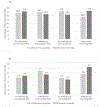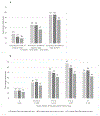Can we increase smokers' adherence to nicotine replacement therapy and does this help them quit?
- PMID: 29696311
- PMCID: PMC6141024
- DOI: 10.1007/s00213-018-4903-y
Can we increase smokers' adherence to nicotine replacement therapy and does this help them quit?
Abstract
Objective: To examine the effects of five intervention components on smokers' adherence to combined nicotine patch and nicotine gum during a quit attempt and assess whether adherence is related to cessation.
Method: Smokers interested in quitting (N = 513; 59% female; 87% White) received nicotine patch plus nicotine gum and participated in a 2x2x2x2x2 randomized factorial experiment (i.e., 32 treatment conditions) evaluating five intervention components: (1) medication adherence counseling versus none; (2) automated medication adherence calls versus none; (3) electronic medication monitoring with feedback and counseling versus e-monitoring alone; (4) 26 versus 8 weeks of nicotine patch plus nicotine gum; and (5) maintenance counseling versus none. Adherence was assessed over the first 6 weeks post-target quit day via timeline follow-back (nicotine patch) and electronic medication dispenser (gum).
Results: In the first 6 weeks post-quit day, 12% of participants used no patches or gum, and 40% used the patch every day. Only 1.4% used both patch and gum adherently every day in the 6 weeks post-target quit day. E-monitoring counseling increased gum use (from 1.9 to 2.6 pieces/day; p < .001) but did not increase abstinence. More adherent patch and gum use in the first 6 weeks were each associated with higher point-prevalence abstinence rates through 1 year.
Conclusions: This large experiment with electronic monitoring of nicotine gum adherence showed that e-monitoring counseling increased gum use but not abstinence. Adherence to nicotine patch and to gum were each strongly related to abstinence, but it is unclear whether adherence increases abstinence, or relapse causes medication discontinuation.
Clinical trial registration: ClinicalTrials.gov NCT01120704.
Keywords: Electronic medication monitoring; Medication adherence; Nicotine replacement therapy; Smoking cessation; Tobacco dependence.
Conflict of interest statement
Figures


References
-
- Benjamini Y, Yekutieli D. (2001) The control of the false discovery rate in multiple testing under dependency Ann Stat 29:1165–1188.
Publication types
MeSH terms
Substances
Associated data
Grants and funding
LinkOut - more resources
Full Text Sources
Other Literature Sources
Medical

